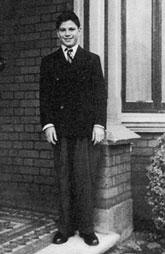
This Article From Issue
March-April 2002
Volume 90, Number 2
DOI: 10.1511/2002.10.0
Uncle Tungsten: Memories of a Chemical Boyhood. Oliver Sacks. viii + 337 pp. Alfred A. Knopf, 2001. $25.
Oliver Sacks's Uncle Tungsten ranks with a very few books—Gerald Durrell's My Family and Other Animals (1956) is one—in conveying the sense of wonder of a little boy facing nature. In evoking convincingly a child's thought processes and language, Sacks achieves a magical retrieval of Time Lost and shares with the reader his elation at this feat. Light, engaging and witty, this candid and detailed memoir chronicles the making of a scientist.

From Uncle Tungsten.
Like Durrell's book, Uncle Tungsten has endearing portraits of family members, particularly Sacks's two wise and understanding uncles, Abe and Dave. (Dave was called "Tungsten" because he manufactured light bulbs with tungsten wire in them.) And like Durrell's book it is at times hilarious. In one anecdote, Sacks tells of baking a "damper" (a hard disk of unleavened flour) for the Cub Scouts. After discovering that the family flour bin was empty, he imaginatively decided to replace the flour in the recipe with cement. The result was a garlic-flavored "damperlike oval," and his scoutmaster, lured perhaps by "the unusually heavy nourishment it promised," broke a tooth on it. Sacks hints that he was here acting out an aggressivity perhaps related to the traumatic experiences and feelings of abandonment he had experienced when he was evacuated to the countryside during the London Blitz.
I hope that Sacks's popularity as a chronicler of neuropathology will result in a wide audience of lay readers and scientists for Uncle Tungsten and will in turn attract the reading public to the subject of chemistry. Although the ostensible switch in his material from neurology to 19th-century chemistry may surprise some, any devotee of his books will recognize familiar themes: He is indignant at rough treatment and bullying tactics—here, those of the vicious and sadistic headmaster of the boarding school he was sent to during the Blitz. And he is fascinated with transcendence—chemical magic gives him "sudden raptures of the mind, . . . sudden landscapes of glory and illumination."
We owe this book to Roald Hoffmann, who sowed the seed for it in Sacks's mind by mailing him a parcel of various chemicals and chemical artifacts. When a small bar of tungsten fell out of the package, the image of Uncle Dave and his wing collar and tungsten-blackened hands imposed itself on Sacks's mind. Two million words later, he had written the manuscript that was pruned to make this book.
Sacks tells how recourse to the elements of chemistry—metals especially—brought order to his mental world. Mendeleyev's periodic table gave it overarching harmony. As a boy, Sacks was sufficiently enthralled by chemistry that he might very well have become a chemist. He became a neurologist instead, in part because of family pressure to become a physician in the family tradition. He had also become disenchanted with chemistry when he realized that it had jettisoned description and the sensory perceptions he craved in favor of quantum calculations. He had no great taste for molecular concepts; indeed, he was an Aristotelian essentialist. In Uncle Tungsten, each chemical element is characterized by features such as its name, density, atomic dimension, crystalline lattice, fluorescence of dissolved salts and so forth. For Sacks, his disenchantment with chemistry amounted to expulsion from the Garden of Eden.
Even professional chemists stand to learn a lot from this book. That a nonchemist would write what is actually one of the best books about chemistry ever written is an interesting paradox. Like the mineral cryolite, Uncle Tungsten is transparent, a gem of a book.—Pierre Laszlo, Emeritus Professor, Chemistry, École polytechnique, Paris, and University of Liège
American Scientist Comments and Discussion
To discuss our articles or comment on them, please share them and tag American Scientist on social media platforms. Here are links to our profiles on Twitter, Facebook, and LinkedIn.
If we re-share your post, we will moderate comments/discussion following our comments policy.